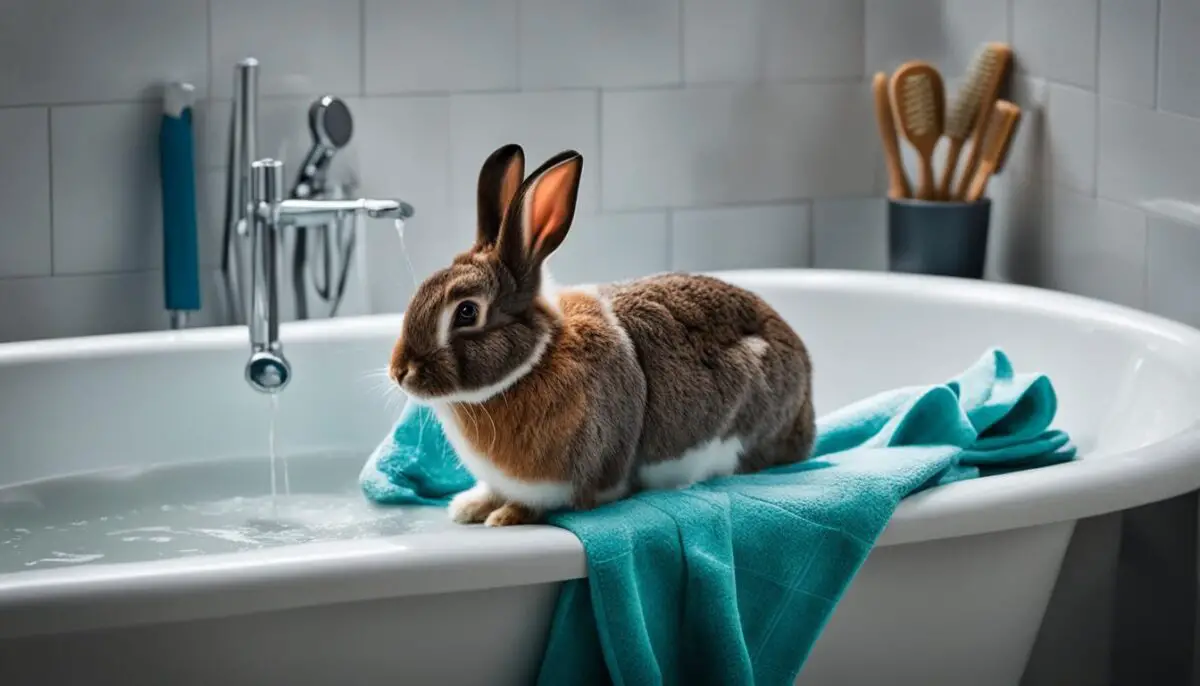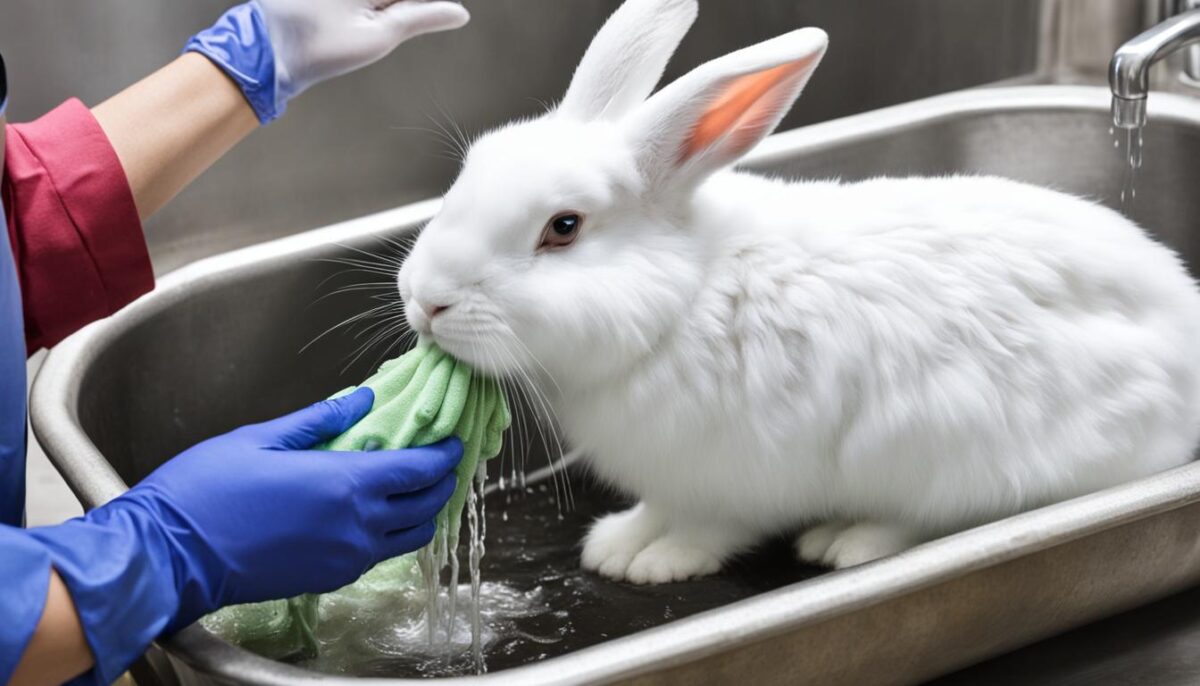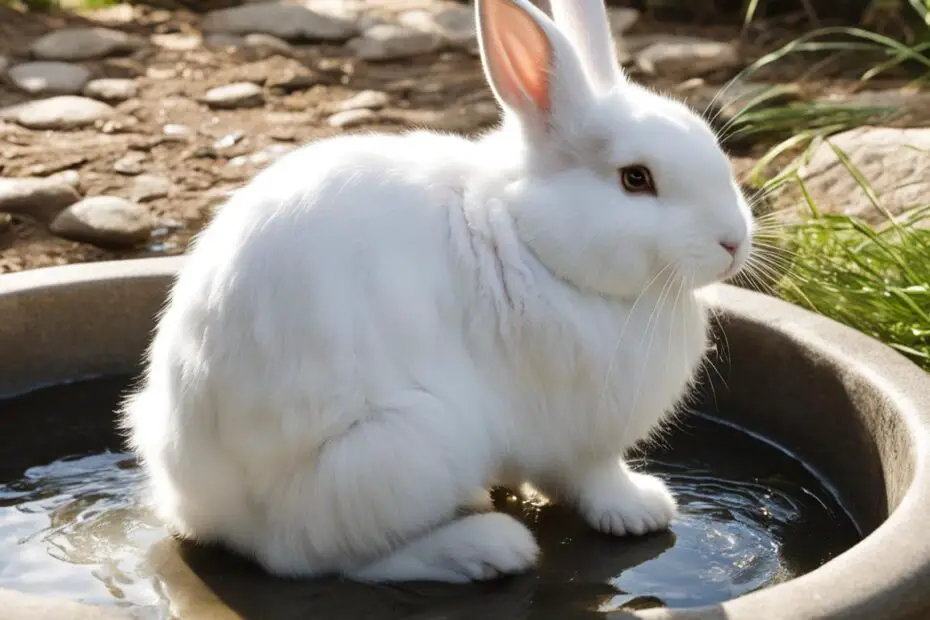When it comes to rabbit care, one common question that pet owners often ask is, “Can I bathe my rabbit?” While bathing may seem like a necessary part of pet hygiene, it’s important to know that rabbits have their own unique grooming habits and may not require regular bathing like other pets.
Rabbits are meticulous groomers by nature and spend a significant amount of time cleaning themselves. Their saliva contains enzymes that help keep their fur clean and free from odors. However, there may be certain situations where a rabbit needs to be bathed, such as when they have a dirty back end due to underlying health issues.
Before considering bathing your rabbit, it is crucial to consult a veterinarian. They can assess your rabbit’s specific needs and provide guidance on whether bathing is necessary and how to do it safely.
Key Takeaways
- Bathing rabbits is generally not necessary and can be harmful to their health.
- Rabbits groom themselves regularly and have their own natural cleaning mechanisms.
- If a rabbit needs to be bathed, it is important to consult a veterinarian for guidance.
- Spot cleaning and regular grooming are essential for maintaining a rabbit’s hygiene.
- Always prioritize your rabbit’s safety and well-being when considering any grooming practices.
The Dangers of Bathing a Rabbit
While the thought of giving your rabbit a bath might seem like a good idea, it’s important to understand the potential risks involved. Bathing rabbits can be dangerous and should only be done under specific circumstances and with proper guidance. Here are some of the dangers you should be aware of:
Panic and Potential Injuries
Rabbits are naturally prey animals and are known to panic when submerged in water. This can lead to them thrashing around, potentially injuring themselves in the process. Limb or spinal fractures are not uncommon when rabbits are in distress. To avoid unnecessary harm, it is generally advised to avoid bathing rabbits unless recommended by a veterinarian.
Respiratory Infections and Hypothermia
Wet rabbits are more prone to respiratory infections and hypothermia. Their fur is designed to keep them warm and dry, and when it becomes soaked, it loses its insulating properties, making them vulnerable to these health conditions. Keeping your rabbit dry is essential for their well-being, and routine bathing is unnecessary as rabbits are naturally clean animals and groom themselves regularly.
Remember, rabbits have evolved to keep themselves clean through their natural grooming behaviors. In most cases, they do not require human intervention to maintain their hygiene successfully. If you have concerns about your rabbit’s cleanliness or smell, consult a veterinarian for appropriate guidance.

The image above showcases a rabbit being safely groomed, highlighting the importance of proper rabbit grooming practices. Grooming plays a crucial role in maintaining a rabbit’s overall health and hygiene.
Spot Cleaning a Rabbit
While full-body bathing can be risky for rabbits, spot cleaning is a safer alternative for maintaining their hygiene. Spot cleaning is especially important for rabbits with underlying health problems that prevent them from keeping themselves clean. If your rabbit has a dirty back end, here’s how you can safely spot clean them:
- Prepare a small bowl of warm water. Ensure that the water is not too hot or cold, as extreme temperatures can be uncomfortable for your rabbit.
- Dip a soft cotton ball or cloth into the warm water. Make sure to squeeze out any excess water to avoid soaking your rabbit.
- Gently wipe the soiled area using the damp cotton ball or cloth. Be careful not to rub too hard or irritate your rabbit’s sensitive skin.
- If necessary, you can use a mild pet-safe shampoo specifically formulated for rabbits. Apply a small amount onto the damp cotton ball or cloth and carefully cleanse the soiled area.
- Rinse off any remaining shampoo residue by wiping the area with a clean, damp cotton ball or cloth.
- Dry the spot-cleaned area thoroughly using a soft towel. Ensure that your rabbit is completely dry before returning them to their living environment.
Remember, it is crucial to consult a veterinarian for guidance on spot cleaning your rabbit. They can provide specific instructions based on your rabbit’s needs and underlying health conditions.
Proper spot cleaning helps to maintain your rabbit’s cleanliness and prevent discomfort or infection. By following these steps and seeking professional advice, you can ensure a safe and effective spot cleaning routine for your beloved pet.

This method helps to remove any waste matter and keep the area clean, promoting the rabbit’s overall well-being. It is essential to consult a veterinarian for guidance on how to properly perform a butt bath, ensuring the process is safe and effective for your pet.
Here are some important rabbit bathing tips to keep in mind:
- Ensure you have all the necessary supplies ready before starting the butt bath.
- Gently sprinkle a small amount of baby cornstarch powder on the soiled area, avoiding contact with the rabbit’s sensitive areas like the reproductive organs.
- Use your hands or a soft cloth to gently massage the powder into the fur, loosening any dried waste matter.
- Carefully remove any dislodged waste matter from the fur using a comb or your fingers, being extremely gentle to avoid causing any discomfort or pain to the rabbit.
- Once the waste matter is removed, use a dry cloth or tissue to wipe away any excess powder, leaving the area clean and dry.
- Monitor your rabbit’s behavior and well-being after the butt bath to ensure they are not experiencing any discomfort or adverse reactions.
Remember, the cleanliness and hygiene of a rabbit’s bottom is crucial for their overall health. However, it is important to consult a veterinarian for any underlying health issues that may be causing the soiling, as simply cleaning the bottom area might not address the root cause.
Bathing a Rabbit for Medical Reasons
In some cases, a veterinarian may recommend bathing a rabbit for medical reasons, such as when they have specific skin conditions that require medicated shampoos. If bathing is necessary, it is crucial to follow the veterinarian’s instructions carefully to ensure the rabbit’s well-being.
Firstly, it’s important to gather all the necessary supplies before starting the process. This includes a mild, rabbit-safe shampoo recommended by the veterinarian, warm water, a towel, and a gentle brush suitable for rabbits.
Start by filling a basin or sink with a few inches of warm water. Make sure the water temperature is comfortable for the rabbit, as it shouldn’t be too hot or too cold. Remember to avoid getting water in the rabbit’s eyes and ears, which can cause discomfort or even lead to infections.
Next, gently place the rabbit in the water, making sure to support its body and keep its head above the water. Use your hand or a cup to pour water over the rabbit’s body, starting from the back and working your way towards the head. Use the rabbit-safe shampoo and lather it gently onto the rabbit’s fur, avoiding any sensitive areas.
After applying the shampoo, thoroughly rinse the rabbit’s fur with clean warm water. Make sure to remove all traces of the shampoo to prevent any skin irritations or reactions. Take extra care not to stress or frighten the rabbit during this process.
Pro Tip:
When bathing a rabbit, it’s important to maintain a calm and soothing environment. Speak softly to the rabbit and offer treats or small rewards for positive reinforcement.
Once the rinsing is complete, gently lift the rabbit out of the water and place it on a towel. Use the towel to carefully dry the rabbit’s fur, patting it softly and avoiding any vigorous rubbing. It’s essential to ensure that the rabbit is completely dry, as damp fur can lead to health issues such as hypothermia. Consider using a hairdryer on the lowest, coolest setting to dry the fur if necessary, but make sure to keep a safe distance from the rabbit to avoid causing any discomfort.
Finally, after the rabbit is completely dry, gently brush its fur to remove any tangles and help restore its natural fluffiness. This will also allow you to inspect the skin for any abnormalities or signs of irritation. If you notice anything concerning, it’s always best to consult with a veterinarian for further guidance.
Bathing a rabbit for medical reasons should only be done under the supervision and recommendation of a veterinarian. They will provide specific instructions based on the rabbit’s medical condition, ensuring the safest and most effective bathing process.
Rabbit Bathing Tips:
- Consult a veterinarian before bathing a rabbit, especially for medical reasons.
- Use a mild, rabbit-safe shampoo recommended by the veterinarian.
- Avoid getting water in the rabbit’s eyes and ears.
- Ensure the water temperature is comfortable and not too hot or cold.
- Thoroughly rinse the rabbit’s fur to remove all traces of shampoo.
- Carefully dry the rabbit’s fur to prevent dampness and potential health issues.
- Brush the rabbit’s fur after drying to remove tangles and inspect the skin.
Remember, regular grooming and maintaining a clean living environment are key to ensuring a healthy and happy rabbit. However, bathing should be done sparingly and only when necessary for medical reasons under professional guidance. By following these tips, you can provide the best care for your rabbit’s hygiene and well-being.
Bathing a Rabbit with Fleas
If your rabbit has fleas, it is crucial to take immediate action to ensure their health and well-being. Consulting a veterinarian for appropriate flea treatment is essential, as they can recommend pet-specific flea solutions formulated specifically for rabbits.
When using flea treatment, it is important to follow the veterinarian’s instructions carefully. Apply the recommended dosage between the shoulder blades, where the rabbit cannot reach to lick the solution. This prevents them from ingesting any potentially harmful chemicals.
In addition to treating your rabbit, it is equally important to tackle the flea problem at its source. Thoroughly clean your rabbit’s living area to eliminate fleas and prevent reinfestation. Wash any bedding, vacuum the area, and consider using pet-safe flea spray or powder to target fleas and their eggs.
Remember, fleas can be persistent pests, so it may take time and multiple treatments to fully eradicate them. Consistency and diligence in following the veterinarian’s recommendations is key to successfully eliminating fleas and protecting your rabbit from further infestation.
Rabbit Flea Treatment Safety Tips
While treating your rabbit for fleas, it is important to consider their safety and well-being. Here are some important tips to keep in mind:
- Choose flea treatments specifically formulated for rabbits.
- Follow the veterinarian’s instructions regarding dosage and application.
- Avoid contact with the rabbit’s eyes and ears when applying the treatment.
- Ensure the rabbit is in a safe and calm environment during the treatment process to minimize stress.
- Monitor your rabbit closely for any adverse reactions or discomfort after the flea treatment.
By following these tips and working closely with a veterinarian, you can effectively rid your rabbit of fleas and create a safe and comfortable living environment for them.
| Flea Treatment Steps | Precautions |
|---|---|
| Consult a veterinarian for appropriate flea treatment. | Ensure the flea treatment is specifically formulated for rabbits. |
| Apply the recommended dosage between the shoulder blades. | Prevent the rabbit from ingesting the flea treatment. |
| Thoroughly clean the rabbit’s living area. | Use pet-safe flea spray or powder to eliminate fleas and their eggs. |
| Monitor your rabbit closely for any adverse reactions. | Keep the rabbit in a calm environment during the flea treatment. |
Conclusion
In conclusion, it is generally not necessary to bathe a rabbit unless recommended by a veterinarian. Spot cleaning of the rabbit’s bottom can be done using baby cornstarch powder. Regular grooming, including brushing and nail trimming, is important for maintaining a rabbit’s hygiene. If bathing is necessary for medical reasons or flea treatment, it is crucial to follow the veterinarian’s instructions carefully to ensure the rabbit’s safety and well-being.
FAQ
Can I bathe my rabbit?
Bathing rabbits is generally not necessary and can be harmful to their health. Wet rabbit hair clumps together, making it difficult to dry them completely, which can result in respiratory infections and hypothermia. However, there may be certain situations where a rabbit needs to be bathed, such as when they have a dirty back end due to underlying health issues. It is important to consult a veterinarian before bathing a rabbit.
Is bathing a rabbit dangerous?
Bathing rabbits can be dangerous as they tend to panic when in water. They can easily fracture their limbs or spine if they thrash around. Wet rabbits are also prone to respiratory infections and hypothermia. Therefore, it is generally advised not to bathe rabbits unless it is recommended by a veterinarian. In addition, rabbits are clean animals and groom themselves regularly, so routine bathing is unnecessary.
How do I spot clean a rabbit?
Spot cleaning a rabbit is a safer alternative to full-body bathing. If a rabbit has a dirty back end, it may be necessary to clean that area using a cotton ball dipped in warm water. This is especially important for rabbits with underlying health problems that prevent them from keeping themselves clean. However, it is important to consult a veterinarian for guidance on how to properly spot clean a rabbit.
What are some tips for grooming a rabbit?
Regular grooming is important for rabbits to maintain their fur and overall hygiene. Brushing a rabbit with a brush made specifically for rabbit fur can help remove dirt and bedding particles. For long-haired rabbits, trimming their fur to about an inch length can prevent tangles and excessive shedding. Additionally, trimming a rabbit’s nails is necessary for indoor rabbits to prevent overgrowth.
How do I bathe a rabbit’s bottom?
Sometimes, rabbits may require spot cleaning of their bottom area due to soiling caused by a variety of health issues. To clean a rabbit’s bottom, a gentle “butt bath” can be done using baby cornstarch powder. This helps to remove any waste matter and keep the area clean. It is important to consult a veterinarian for guidance on how to properly perform a butt bath.
Can I bathe a rabbit for medical reasons?
In some cases, a veterinarian may recommend bathing a rabbit for medical reasons, such as medicated shampoos for specific skin conditions. If bathing is necessary, it is important to follow the veterinarian’s instructions carefully. This may include using warm water and avoiding contact with the rabbit’s eyes and ears. It is also important to ensure the rabbit is dried thoroughly before being placed back in its living environment.
How do I bathe a rabbit with fleas?
If a rabbit has fleas, it is important to consult a veterinarian for appropriate flea treatment. Pet-specific flea solutions formulated for rabbits should be used, and the recommended dosage should be applied between the shoulder blades. Additionally, thorough cleaning of the rabbit’s living area is necessary to eliminate fleas and prevent reinfestation.
What is the conclusion about bathing rabbits?
In conclusion, it is generally not necessary to bathe a rabbit unless recommended by a veterinarian. Spot cleaning of the rabbit’s bottom can be done using baby cornstarch powder. Regular grooming, including brushing and nail trimming, is important for maintaining a rabbit’s hygiene. If bathing is necessary for medical reasons or flea treatment, it is crucial to follow the veterinarian’s instructions carefully to ensure the rabbit’s safety and well-being.


